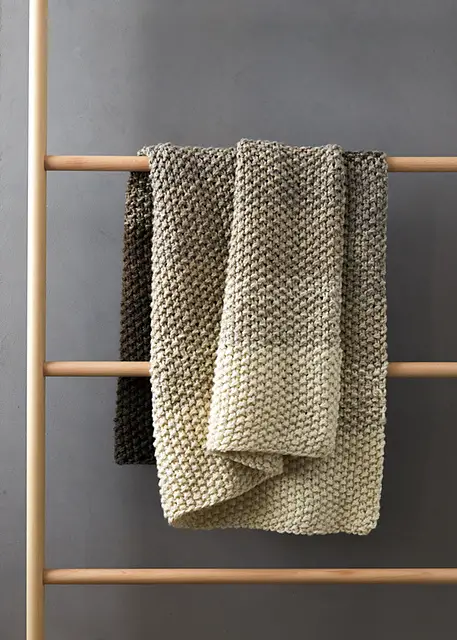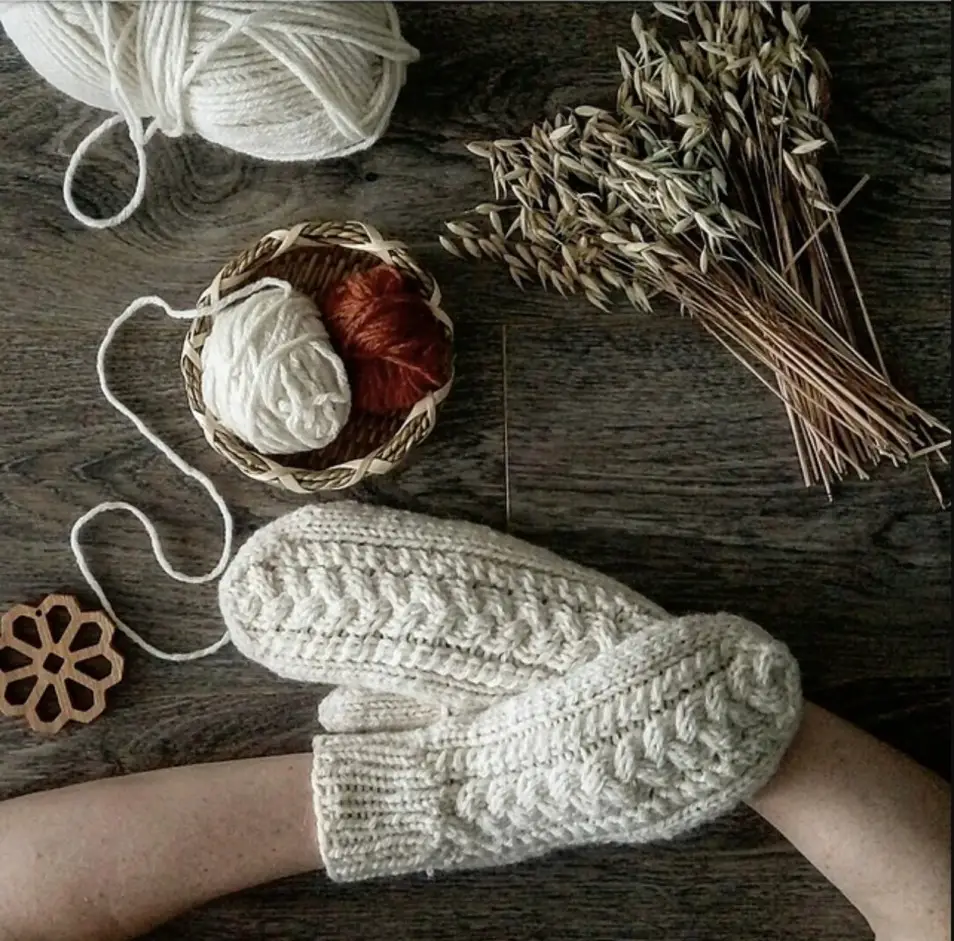The first sweater I ever knit was made out of bulky weight yarn. I heard that bulky yarn was better for beginners because it’s easier to work with and faster to knit up. And I would have to agree. I really enjoyed knitting with bulky weight yarn and think it would be great for crochet too. But what is bulky weight yarn you may be asking yourself.
Bulky weight yarn is often synonymous to any yarn thicker than worsted or aran weight. However, the Craft Yarn Council’s standard for bulky is size 5 (out of 7). The fabric is thick and warm, perfect for cold weather garments and accessories, and blankets.
I know how difficult it can be to choose yarn when you are starting out. You just want to buy a skein with a good color that feels soft. But the yarn weight matters when you want a certain look to your project.
Just check out the top photographs. The blanket and the mittens wouldn’t have that thick, warm fabric if they were made from a different yarn weight. If you want to snag the free patterns, click the links: Big Good Blanket by Purl Soho and Tiilda Mittens by Inese Sang.
In my previous articles we learned about Lace Weight, Super Fine, Fine Weight, Light/DK Weight, and Medium/Worsted Weightyarn. In this one, I want to cover bulky weight yarn and explain what the industry means by the term. Please join me!
Bulky Weight Yarn Standards
The Craft Yarn Council (CYC) created a standard yarn weight system for the US. It is based on a number system that starts from 0, the thinnest, and goes up to 7, the thickest. Bulky weight yarn is what the CYC considers a 5. Besides the numbering system, the CYC also gives guidelines for gauge and hook/needle sizes for bulky weight yarn.
CYC Gauge and Tool Recommendations
Gauge, hook and needle suggestions for knit and crochet are printed on the labels. These are based on the testing done by the yarn manufacturers.
But the CYC put a set of guidelines for everyone (in the US) to use, which is listed below. The information is based off of the CYC website and you can access that here for more details.
| | Standard CYC Gauge* | CYC Recommended Tool Size |
| Knit | 12 – 15 sts stockinette | 5.5 – 8mm, 9 – 11(US) needles |
| Crochet | 8 – 11 sts sc | 6.5 – 9mm, K10 – M13(US) hook |
Ravelry (an online database for crochet and knitting patterns) also provides a guideline for knit gauge. According to them, you should get 14-15 stitches per 4 inches (10 cm). You can see that this is in align with what the CYC says.
Remember though, these are not exact. The gauge and hook/needle size provide you with a strong baseline, but you should always do your own testing.
Wraps Per Inch
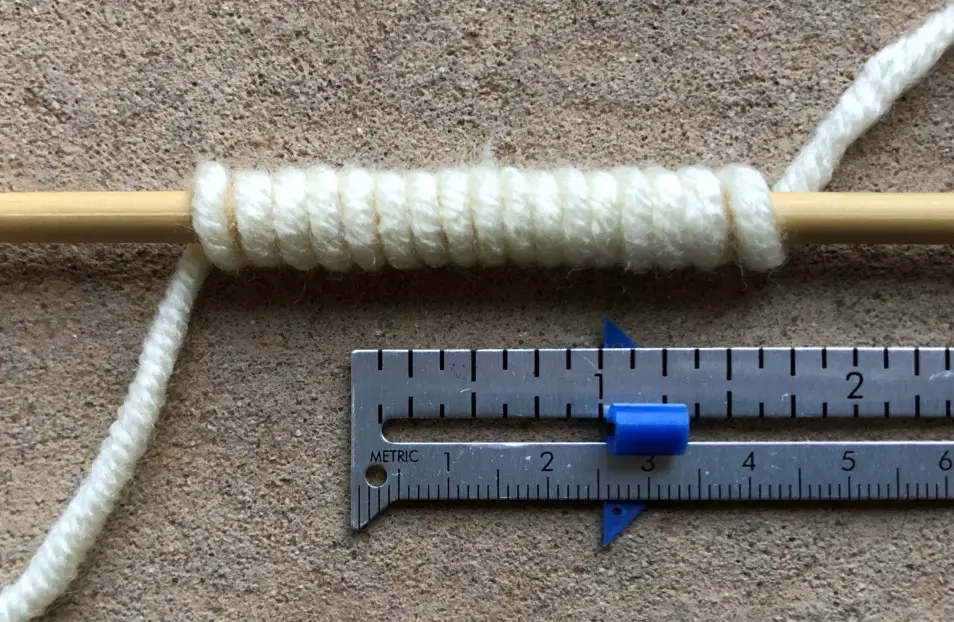
Wraps per inch (WPI) is useful for yarn weights if you ever lose your labels. Measuring WPI is super simple. The CYC has more detailed information on their website here. But basically you wrap yarn around a pencil. Then you measure an inch and count how many wraps are in that inch. Finally, you compare to the CYC standards for WPI to know what the yarn weight is.
The CYC states that bulky weight (5) should have 6-9 wraps per inch. Ravelry also has a section for WPI on their yarn weight standards page. They state that 7 WPI should be expected for bulky weight yarn.
Finally, another source, Bluprint, says that you can expect 7-8 WPI for bulky weight yarns. This is exactly in line with the CYC says. If you are curious, check out their article here.
Other Common Terms for Bulky Weight Yarn
As I mentioned previously, the CYC created the yarn weight system for the US. Bulky weight is equivalent to a 5 according to their standards. But not everyone in the world uses the same terminology. I summarized the most common terms used for bulky weight yarn below, and I will go into more detail about each.
Also Known As
- Bulky – 5
- Chunky
- Craft
- Rug
- Double Double
- 12-ply
- 14-ply
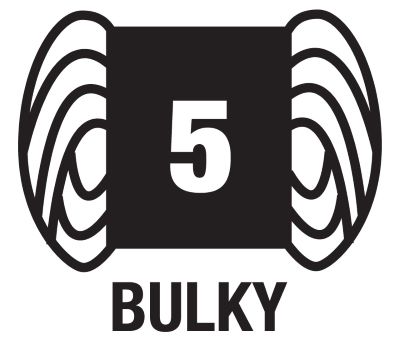
In the US, and other countries, bulky weight yarn is also commonly called chunky. Often, these terms are used interchangeably to mean any yarn that is thicker than medium weight. But these are not the only terms used. Let’s look at some others.
- Bulky – 5. This is how the CYC defines the next weight thicker than worsted or aran, which are medium weight (4) yarns.
- Chunky. “Chunky” or even “bulky” often is used to refer to texture rather than yarn weight. So don’t be confused by the terms. Just always check gauge to ensure it truly is a “bulky” weight yarn.
- Craft. The CYC labels bulky weight 5 yarn as “craft.” That was the only place I came across the term. But in my experience, no one calls it that.
- Rug. This term also comes from the CYC yarn weight standards. It is my understanding that the term “rug” is used because to make rugs with yarn, a thick and heavyweight yarn is needed.
- Double Double. This is a rare term used for bulky weight yarn. I’m not entirely sure where it originated, but I came across the term a couple times in my research.
The UK, Australia and New Zealand tend to refer to yarn weights by plies. The lower the ply count, the thinner the yarn. Although, don’t confuse this with how many plies the yarn is actually composed of. Ply count used to refer to the number of strands in the yarn, but modern processes have changed that. Now the term ply simply means the thickness of the yarn, when referring to yarn weights.
I looked at several sources to hopefully give the most accurate information, as I live in the US and don’t use this notation for yarn weights. This is what I found.
- 12-ply. On Ravelry, 12-ply is listed as the term used in Australia, New Zealand and the UK.
- 14-ply. I found a couple of sources that says New Zealand uses the term 14-ply as well.
If you live in one of the areas that uses ply to determine yarn weight, please let me know if I should update this section!
Important Properties of Bulky Weight Yarn
Bulky weight yarn has several important properties that affect every purchaser of yarn. First there is fiber content. It is important to know what fibers the yarn is made from so you know how to treat it for your projects. Next, the yardage is important because that affects the project size. Finally, the price of the yarn is an important property that affects whether or nor you buy it.
Throughout these next sections, I dive deeper into each property of bulky weight yarn. In order to do so, I conducted my own research. I looked at five major yarn companies so I could understand more about industry behaviors regarding yarn weights. I hope you find it interesting!
Common Fiber Content
I like to break fiber content into three categories: natural fibers, synthetic fibers, and blends of natural and synthetic fibers. According to my research, 12% of bulky weight yarn is made from natural fibers and 62% is made from synthetic fibers. The other 26% is a blend of natural and synthetic fibers.
I was a little surprised by these results. I figured more natural fibers would be used for bulky weight yarn since it’s used for garments and accessories. Although, synthetic fibers make sense for the same reason since they are easier to wash and inexpensive.
I have summarized the common fibers below. I didn’t add the blends though because that can vary.
Natural Fibers
- Wool
- Merino
- Cashmere
- Mohair
- Cotton
- Alpaca
Synthetic Fibers
- Acrylic
- Polyester
- Polyamide
- Nylon
- Viscose
Yardage Estimation
When it comes to yardage, unfortunately there is no set standard for the amount of yards per ounce/gram. That is up to the yarn manufacturer. But I was curious, just as I am sure you are, how many yards I can expect on average for bulky weight yarn. This is super important when planning for a pattern.
As I stated before, I looked at 5 major yarn companies in the US. The following is based on my findings. For bulky weight yarn, you can expect 173 yards per skein on average. The lowest amount of yardage I came across was 50 yards and the highest was 690 yards.
Average Price
Price is also an important aspect to keep in mind when you are choosing and comparing yarn. I found that you can expect to pay on average $7.80 per skein of bulky weight yarn. Of course, that also means you could pay much more or much less depending on where you shop.
Where to Find Bulky Weight Yarn
Bulky weight yarn can be found in many places. Most chain craft stores now carry bulky weight yarn. I used to only find like one or two different bulky weight yarns in-stores, but now they are becoming much more common to see on shelves. And there is usually a decent color selection too.
If you have a locally owned yarn shop in your area, you might have a bigger selection of bulky weight yarn to choose from. I, however, don’t have that luxury, so I can’t say for sure.
Finally, you can always buy bulky weight yarn online. There are many yarn retailers that have bulky weight yarns for sale. The only drawbacks are that you must wait for its arrival (so hard!) and you can’t feel the yarn before purchasing.
Types of Projects Best for Bulky Weight Yarn
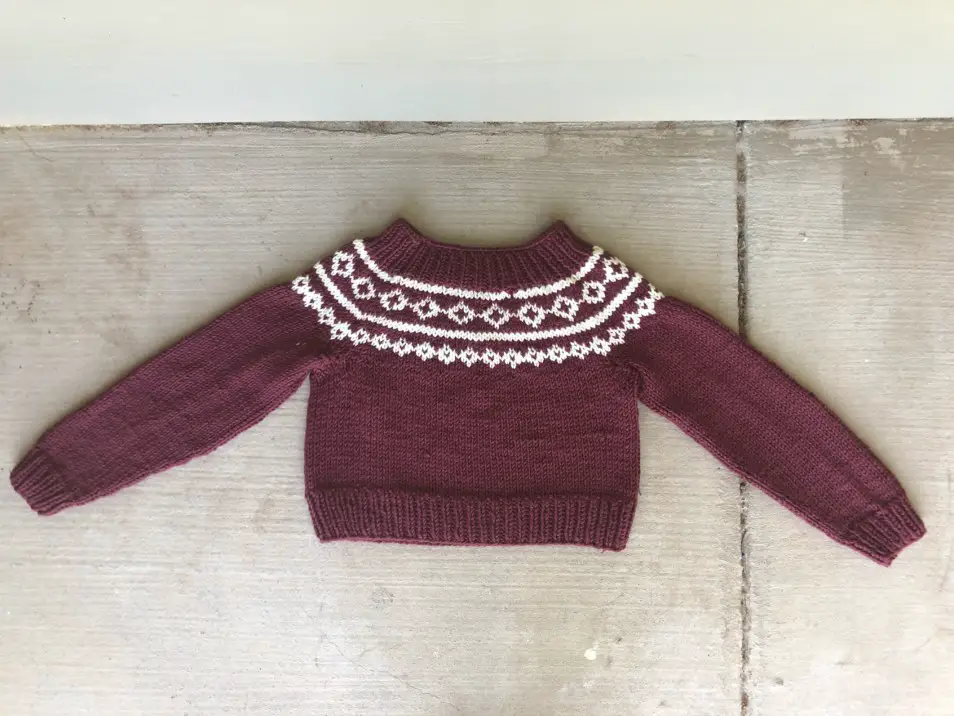
Bulky weight yarn will produce a thick fabric that can provide a lot of warmth.
In comparison to thinner yarn weights, bulky yarn will be very easy to work with, the project will be fast and the stitches are easy to see. It’s the perfect combination for a beginner just learning to knit or crochet.
Ravelry has a total of 58,494 patterns (at the time of this post) that uses bulky weight yarn. And almost half of those are free! You will no doubt find a project that you like.
Popular items to knit or crochet with bulky weight yarn include hats, cowls, sweaters, blankets and home decor. I compiled a bigger list that includes all of the project types that I could think of that pair well with bulky weight yarn. You are by no means limited to only these projects, but I hope these spark inspiration!
Garments
- Sweaters
- Slipper Socks
- Cardigans
- Wraps
Accessories
- Cowls
- Hats
- Headbands
- Mittens
- Scarves
- Bags
Home Decor
- Blankets
- Baskets
Bulky Weight Yarn Recommendations + Tips
I’ve tried many different yarns, but these are a few of my recommendations of bulky weight yarn.
- Lion Brand Color Made Easy – I made my first knit sweater out of this!
- Bernat Velvet – I love, love the feel of the soft velvet yarn. I made this into a blanket once!
- Lion Brand Homespun – Remember those big viking beards made of yarn that were popular? I made my entire family beards for Christmas (as a joke) with this yarn years ago!
Tips:
- Use bulky weight yarn when learning to knit and/or crochet. The bulky weight yarn will create nice, big stitches. Perfect for any beginner to learn what a good stitch should look like. Also, the bulky weight yarn requires the use of big knitting needles and crochet hooks. This makes it easier for the beginner to hold so they can focus on the process of making stitches. Finally, bulky weight yarn will keep any beginner motivated because the yarn works up quickly so you can see the end is near.
- Buy more than you think you will need. Bulky weight yarn comes with less yardage compared to thinner weight yarns. It’s better to plan with more than enough than not enough.
- Use basic crochet or knit stitches. Bulky yarn does not show texture well, especially from complicated stitch patterns. It’s best to go with what is simple.
- Make sure tension is loose. You want room for the stitches to breathe, otherwise you will end up with a thick, stiff fabric. That is not ideal when making garments and many accessories. Use a bigger crochet hook or knitting needle if your stitches are too tight.
Up Next
That concludes Bulky Weight yarn (5). The next post covers Super Bulky Weight yarn (6), which is the next size up of yarn. You can find it here.
The pictures listed at the top of the post are available in pattern form free through Ravelry. I do not claim these photos as my own, they are merely for illustration purposes. Click the links here to find the free patterns: Big Good Blanket, Tiilda Mittens.

